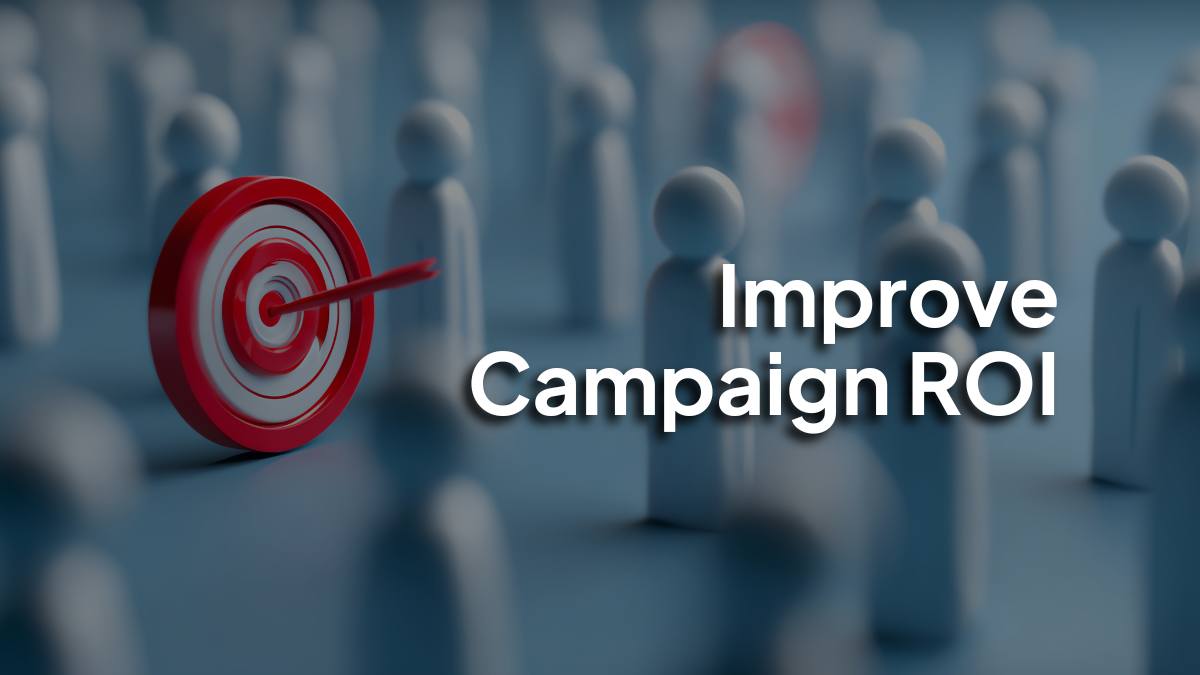Table of Contents
Introduction
Campaign ROI is basically how much bang we get for our marketing buck. It’s simple in theory: how much money a campaign brings in versus how much we put into it, but in practice, it’s where a lot of businesses stumble. You can spend thousands on ads, emails, or social content and never really know if it’s working unless you track ROI carefully.
Customer data is where the magic starts. Knowing how people behave, what they buy, where they click, even what makes them ignore your emails, this stuff matters. But here’s the thing: having data isn’t enough. You need to measure the right metrics to actually see if your campaigns are paying off.
Quick TL;DR
- ROI tells us if marketing spend is worth it.
- Customer data helps target better and speak directly to audiences.
- The right metrics show which campaigns deserve more budget and which don’t.
What is Campaign ROI and Why It Matters
ROI is the scorecard of marketing. Think of it like a report card for campaigns.
ROI in marketing terms:
- Formula:

(Revenue from Campaign – Cost of Campaign) ÷ Cost of Campaign
- Measures efficiency, how much return we get from each dollar spent.
Different ways to look at ROI:
- Revenue-Based: Did this campaign make money directly?
- Lead-Based: How valuable are the leads we got?
- Engagement-Based: Are people interacting, sharing, clicking? Sometimes this is more about brand awareness than immediate sales.
Why ROI tracking is critical:
- Helps us decide where to put money next.
- Shows what actually works instead of what “looks” good.
- Makes marketing smarter, not just busier.
- Let’s make decisions based on numbers, not guesses.
ROI isn’t just a number. It’s a lens for making campaigns better over time.
How Customer Data Drives Campaign ROI
Customer data is like a map. Without it, campaigns are mostly guessing.
Types of customer data we use:
- Behavioral: Pages people visit, links they click, time spent.
- Transactional: Past purchases, order patterns, average spend.
- Demographic: Age, gender, location, job.
- Psychographic: Interests, lifestyle choices, values.
How it helps ROI:
- Targets the right people instead of spraying ads everywhere.
- Personalizes messaging so it actually feels relevant.
- Let’s predict what customers want before we spend heavily on campaigns.
- Improves campaigns by tweaking messaging, creative, and timing.
Real-world pattern:
- E-commerce sites that show products based on what users browsed tend to see better conversion.
- B2B campaigns that target by role and industry often get more engagement with less spend.
The point is simple: smart use of customer data makes campaigns work harder. Sometimes small tweaks make a big difference.
Key Metrics to Measure and Improve Campaign ROI
1. Conversion Rate
Conversion rate is simply how many people do what we want. Buy, sign up, download, whatever matters. If it’s low, something’s off. Maybe the audience isn’t right. Maybe the message isn’t landing. Watching this metric closely shows where tweaks are needed. Even tiny changes in copy, buttons, or layout can shift results noticeably.
2. Cost Per Acquisition (CPA)
CPA is the price to get one customer. Lower isn’t always better. Smarter is better. Adjust targeting. Test landing pages. Tweak offers. Little changes here can drop CPA fast. Saving a few dollars per acquisition adds up. It frees up budget for campaigns that actually deliver results.
3. Customer Lifetime Value (CLV)
CLV looks past the first sale. It estimates what a customer spends over time. High CLV means it’s worth investing more upfront to reach the right people. Campaigns then focus on lasting value, not just quick wins. Repeat purchases, long-term engagement, that’s what really moves ROI.
4. Engagement Metrics
Clicks, opens, shares, likes, they don’t always bring revenue straight away. But they show what works. High engagement often leads to better conversions later. Tracking engagement shows where messages connect and where they don’t. Sometimes, one small insight can change a whole campaign’s direction.
5. Attribution Models
Not all touchpoints are equal. First-touch, last-touch, multi-touch, they tell different stories. Pick the wrong model and the ROI numbers lie. Misreading attribution wastes money and effort. Accurate tracking shows what channels really drive results. It keeps campaigns honest and performance clear.
Also Read: What Is Digital Marketing ROI
Strategies to Improve Campaign ROI Using Data
1. Segmentation and Personalization
Not every customer is the same. Segment by behavior, location, purchase history, anything that makes sense. Personalize campaigns for each group. Even small adjustments, like a custom offer for loyal customers, can lift ROI a lot. Targeting the right people beats blasting everyone.
2. A/B Testing
Test everything. Headlines, images, call-to-actions. A tiny tweak can change results drastically. Testing removes guesswork. Campaigns get optimized based on what actually works. Keep testing. Never assume something is perfect.
3. Multi-Channel Integration
Use email, social, and ads together. Alone, each channel works. Together, they hit harder. Customers see messages repeatedly in different places. Consistent exposure drives higher ROI. It’s about a seamless journey, not random bursts.
4. Predictive Analytics
Look at past data to predict future performance. It shows which campaigns are likely to succeed. Even simple patterns help make smarter decisions. Less guesswork, more results. Predictive insights let us invest where ROI will be highest.
5. Budget Optimization
Shift money from weak campaigns to strong ones. Don’t cut spending blindly. Watch performance, find winners, and push more resources their way. Smart allocation keeps ROI growing. Every dollar counts, so make it work harder.

Apply Now: Advanced Digital Marketing Course
Tools to Track and Enhance Campaign ROI
1. Marketing Analytics Platforms
Platforms like Google Analytics or HubSpot are basic but powerful. They show where traffic comes from, which pages perform, and how many people convert. It can feel like too much info at first. But even a quick glance shows what’s working. Watch trends, not just numbers. Adjust as you go.
2. Customer Data Platforms (CDPs)
CDPs put all customer info in one place. Browsing, purchases, clicks, all together. No more digging through spreadsheets. Makes it easier to see who your audience really is. Segmentation, personalization, targeting, they all become simpler. Often, opportunities show up you didn’t notice before.
3. Campaign Optimization Tools
Some tools adjust bids, audiences, or ads automatically. Not magic. But they highlight trends humans sometimes miss. Small tweaks get more from every campaign dollar. Even minor changes add up.
4. Example Workflow
Here’s a simple cycle: track conversions → spot high-value segments → tweak campaigns → shift budget. Repeat. Small adjustments matter more than big, risky moves.
Also Read: What are Marketing Metrics?
Common Pitfalls That Reduce Campaign ROI
1. Poor Data Quality
Bad data leads to bad campaigns. Missing info, outdated records, or mistakes can waste money. Campaigns hit the wrong people. Messages flop. Cleaning data is tedious but worth it.
2. Ignoring Attribution
Not all conversions are created equal. First-click, last-click, multi-touch, they tell different stories. Skip this, and money goes to the wrong places. ROI looks worse than it actually is.
3. Relying on One Channel Too Much
Email alone or social alone rarely works. Every channel behaves differently. Testing a mix is safer and smarter. Diversification often improves results.
4. Not Acting on Data
Collecting data without action is pointless. Campaigns must change based on performance. Even small adjustments can boost ROI. Waiting too long costs money and momentum.
Also Read: Top Performance Marketing Metrics
Future Trends in Improving Campaign ROI
1. Smarter Automation
Automation keeps growing. Campaigns can tweak themselves, bids, targeting, even messages, without waiting for a human to micromanage everything. Doesn’t mean you can ignore strategy. It just makes every dollar stretch further. Small adjustments, repeated often, tend to add up. Teams paying attention notice steady gains.
2. Real-Time Data and Adaptive Campaigns
Waiting weeks to see results? That’s old. Real-time data shows what’s working now. Emails, ads, posts, they can be adjusted quickly. Even minor changes, like swapping an image or headline, make a difference. Flexibility beats rigidity. Reacting fast often wins over perfect planning.
3. Privacy and First-Party Data
Third-party cookies are disappearing. First-party data is now the most valuable. Collect it carefully, store it smartly, use it wisely. Knowing the audience directly improves targeting. Personalization gets sharper. ROI benefits. It’s simple, but not everyone does it.
Also Read: Digital Marketing ROI
Conclusion
ROI improves when campaigns are observed closely and adjusted constantly. Data alone doesn’t help; action does. Watching conversions, CPA, engagement, and lifetime value shows what’s actually working. Small, repeated changes often outperform big, one-off moves. Automation and real-time insights make adjustments faster. Privacy rules mean first-party data is key, and using it right makes campaigns more relevant. Focus on what works, drop what doesn’t. Test messages, tweak creative, move budget to top performers. It’s not about perfection. It’s about steady improvement. Every small insight adds up. Campaigns that adapt, measure, and refine consistently tend to get the best ROI.
FAQs: Improve Campaign ROI
How do we calculate campaign ROI accurately?
Campaign ROI is simple in formula: (Revenue from campaign – Campaign cost) ÷ Campaign cost. But the trick is including everything. Don’t forget hidden costs like tools, design, or ad spend. Check consistently. Look at revenue realistically. Repeat calculations for each campaign. Small mistakes can make ROI look better or worse than it really is.
Which metrics have the biggest impact on ROI?
Conversion rate, CPA, and customer lifetime value usually matter most. Engagement, clicks, shares, and opens also tell a story. Attribution is important too, otherwise results can be misleading. Track multiple metrics together. One number rarely tells the full picture. Keep it simple but cover the basics.
Can small businesses improve campaign ROI with limited data?
Yes. Limited data still shows patterns if you focus. Look at core segments. Test messaging and channels. Measure results and tweak. Small, smart changes can make a big difference. Even one or two clear insights can improve targeting, personalization, and ROI noticeably over time.
How often should campaigns be analyzed for ROI improvement?
Depends on campaign type. Fast-moving campaigns, ads, emails, benefit from weekly checks. Slower campaigns, content or seasonal, might work with monthly reviews. Look for trends, not one-off spikes. Adjust budgets, messaging, and targeting based on real performance. Regular monitoring keeps campaigns efficient and ROI growing steadily.

